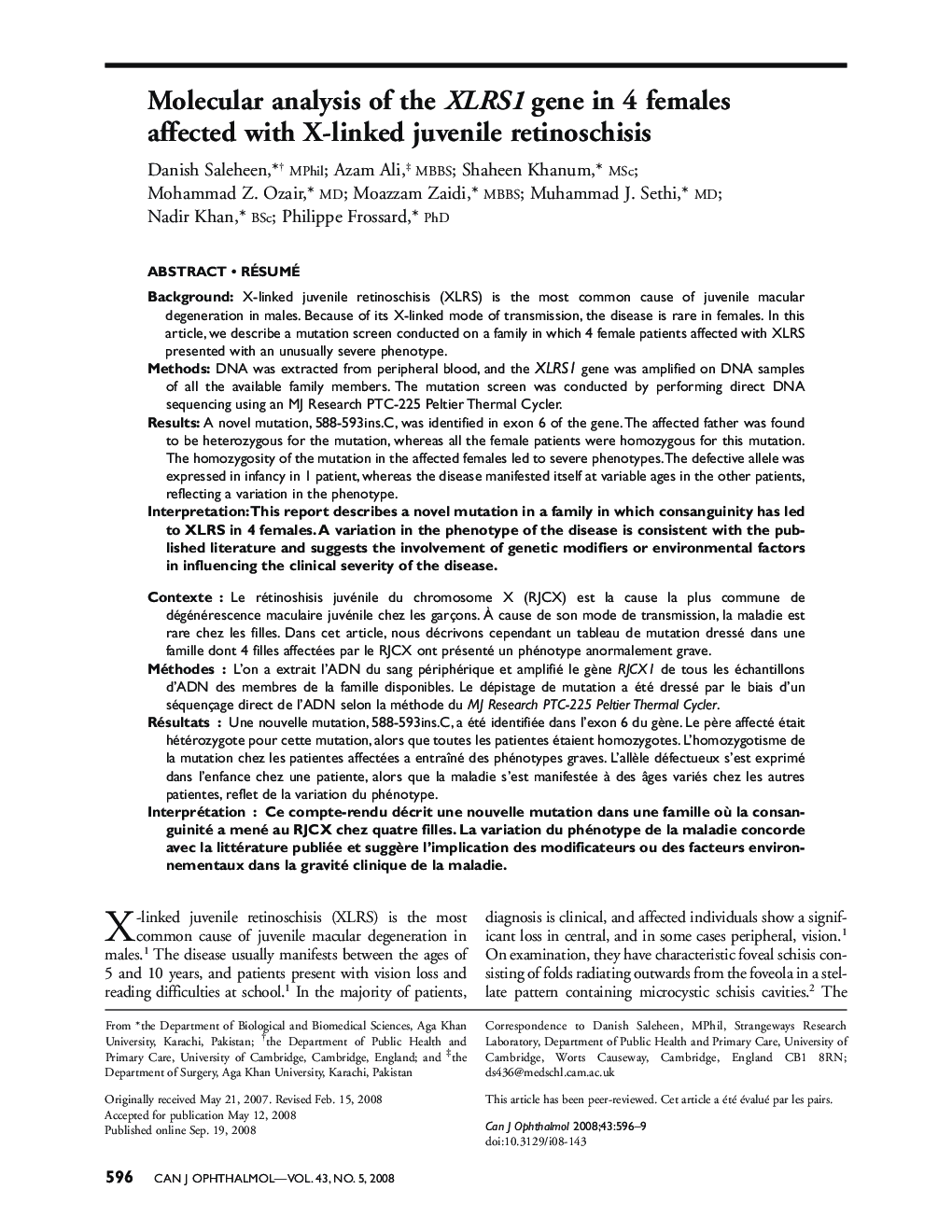| Article ID | Journal | Published Year | Pages | File Type |
|---|---|---|---|---|
| 4010032 | Canadian Journal of Ophthalmology / Journal Canadien d'Ophtalmologie | 2008 | 4 Pages |
Background: X-linked juvenile retinoschisis (XLRS) is the most common cause of juvenile macular degeneration in males. Because of its X-linked mode of transmission, the disease is rare in females. In this article, we describe a mutation screen conducted on a family in which 4 female patients affected with XLRS presented with an unusually severe phenotype.Methods: DNA was extracted from peripheral blood, and the XLRSI gene was amplified on DNA samples of all the available family members. The mutation screen was conducted by performing direct DNA sequencing using an MJ Research PTC-225 Peltier Thermal Cycler.Results: A novel mutation, 588–593ins.C, was identified in exon 6 of the gene. The affected father was found to be heterozygous for the mutation, whereas all the female patients were homozygous for this mutation. The homozygosity of the mutation in the affected females led to severe phenotypes. The defective allele was expressed in infancy in 1 patient, whereas the disease manifested itself at variable ages in the other patients, reflecting a variation in the phenotype.Interpretation: This report describes a novel mutation in a family in which consanguinity has led to XLRS in 4 females. A variation in the phenotype of the disease is consistent with the published literature and suggests the involvement of genetic modifiers or environmental factors in influencing the clinical severity of the disease.
RésuméContexte: Le rétinoshisis juvénile du chromosome X (RJCX) est la cause la plus commune de dégénérescence maculaire juvénile chez les garçons. À cause de son mode de transmission, la maladie est rare chez les filles. Dans cet article, nous décrivons cependant un tableau de mutation dressé dans une famille dont 4 filles affectées par le RJCX ont présenté un phénotype anormalement grave.Méthodes: L’on a extrait l’ADN du sang périphérique et amplifié le gène RJCXI de tous les échantillons d’ADN des membres de la famille disponibles. Le dépistage de mutation a été dressé par le biais d’un séquençage direct de l’ADN selon la méthode du MJ Research PTC-225 Peltier Thermal Cycler.Résultats: Une nouvelle mutation, 588–593ins.C, a été identifiée dans l’exon 6 du gène. Le père affecté était hétérozygote pour cette mutation, alors que toutes les patientes étaient homozygotes. L’homozygotisme de la mutation chez les patientes affectées a entraîné des phénotypes graves. L’allèle défectueux s’est exprimé dans l’enfance chez une patiente, alors que la maladie s’est manifestée à des âges variés chez les autres patientes, reflet de la variation du phénotype.Interprétation: Ce compte-rendu décrit une nouvelle mutation dans une famille où la consanguinité a mené au RJCX chez quatre filles. La variation du phénotype de la maladie concorde avec la littérature publiée et suggère l’implication des modificateurs ou des facteurs environnementaux dans la gravité clinique de la maladie.
